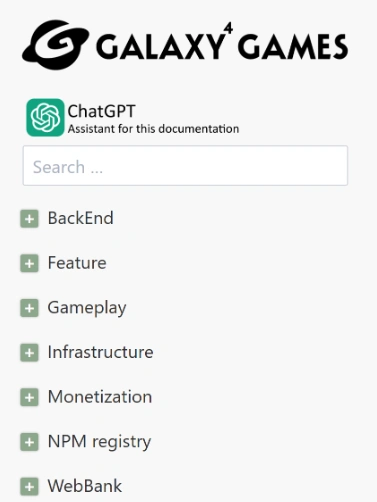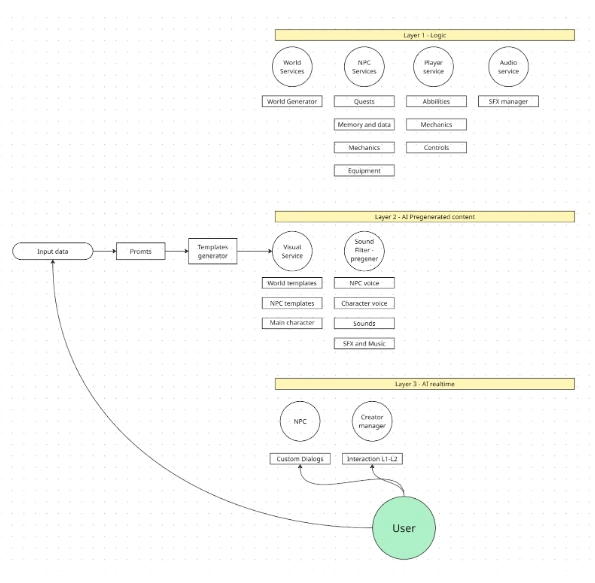AI-Powered Game Development: Turning Ideas into Scalable Games
AI in game development is one of the most exciting - and debated - topics in today’s industry. Some believe that AI-generated games are the inevitable future. Others argue that human creativity and emotional intelligence are irreplaceable.
At Galaxy4Games, we believe the truth lies somewhere in between. AI is not a replacement for human talent - it’s a powerful accelerator that, when used smartly, helps studios build better games faster.
What Is AI-Powered Game Development?
AI in gaming can mean several things, from procedural content generation and testing automation to AI-assisted coding and world-building. But we need to clarify a common misconception.
Two Main Concepts of AI in Games
-
Real-Time AI-Generated Worlds (Conception #1):
Games that adapt infinitely in real-time. Fascinating, but extremely resource-intensive and limited by today’s hardware and budgets. -
Pre-Generated AI Games (Conception #2):
AI builds the core content - art, levels, dialogue, sound, or even basic mechanics - before release. The result is a finished build, not an endlessly evolving game.
This second approach is where AI currently shines - and it’s where Galaxy4Games focuses its development.
Under AI games, we should understand that it’s not a game that generates the picture in real-time, and you can play without limitation (Conception #1). The mechanics built by AI in runtime entirely depend on its “Imagination”. We are referring to pre-generated games, where AI builds a game and then you receive a finished build (Conception #2).
AI can solve various tasks, including content creation (art, SFX, etc.), interaction with game mechanics and databases through inputs, algorithm creation, code tool, testing, and more. But consider AI as a tool.
Galaxy4Games’ Three-Layer AI Game Framework
In Galaxy4Games, we are using AI in various ways, even educating AI to understand our Modular Solutions, and it can easily suggest to you what modules and methods developers can use to realize a feature in the game.

We are developing a system that enables AI to collaborate with our mechanics and modules to deliver a product. Why do we do this?
The Conception #3, which is quite similar to Conception #2, is closer to reality. To achieve balance between structure and flexibility, we designed a three-layer system that integrates AI into our modular game development pipeline.

Layer 1 - Gameplay level. It’s a traditional game that features engaging mechanics and gameplay. The creator could choose the gameplay at this level, set it, and have a game that could be run.
Layer 2 - Per-generation level. Here, the creator could set up visuals, dialogs, quests, sound design, etc. All that can be generated using AI tools. Important: All this content should have been compatible with Layer 1 mechanics.
Layer 3 - Communication. It’s where the user interacts with the gameworld. He can use various requests to NPC, create something, or change his character, which interacts with Layer 1 and 2 to get information, regenerate something, or add a mechanic.
There are also objective reasons for this approach compared to fully AI-generated games.
Why Fully AI-Generated Games Aren’t Practical (Yet)
Game promotion is getting more expensive, AI in run-time requires massive power (and running such games even with cloud-games solutions is extremely expensive), so the ROI business model struggles a lot since you have to earn more to pay for all the power. The more you rely on AI, the more you will pay for maintenance, and the more you should think about expenses in production.
So, AI is not something that can bring fully AI-generated games overnight, especially those generated at runtime. We still have hardware limits, network limits, budgets, and business rentability.
That means we still need gameplay mechanics (games, basically) to run the gameplay process. However, we could use AI to generate content and communicate with a game database and gameworld to achieve a more immersive effect.
And we are building Layer 1 using our Modular Solutions, empowering it with Layer 2 tools and AI technologies. Layer 3 is something we are already implementing in test mode for Skiesverse MMORPG. There is a long way ahead, but we look forward to building a handy and solid editor for creating games with AI.
The Benefits of Smart AI Integration
We live in an era where denying AI’s impact makes no sense. AI can reduce costs, speed up production, and enhance creativity - but only when used strategically.
Smart developers and studios must focus on how to use AI effectively. Clients should seek companies that integrate AI intelligently, not just use it as a buzzword.
Why Use AI in Game Development?
-
Rapid prototyping and investor demos
-
Automated art, SFX, and dialogue generation
-
AI-assisted coding and modular design
-
Testing and bug detection through AI agents
-
Dynamic world-building and player interaction
AI, when used smartly, is not about replacing humans - it’s about amplifying creativity and productivity.
When Clients Ask for “AI-Only” Game Code
Sometimes clients approach us wanting to build a game entirely with AI code. It’s a great starting point, but there are important things to consider:
-
AI still requires a technical person to manage, optimize, and integrate the output.
-
AI-only games make sense for prototyping. They’re great for quickly showcasing ideas to investors.
-
Scaling prototypes into full products is harder. AI-generated code often lacks the structure needed for long-term growth and maintenance.
In short, AI-only development works perfectly for fast proof-of-concept, but a hybrid approach is essential when your goal is to build a scalable product.
AI Game Development Resources & Trends
To stay ahead, developers should explore the top tools, frameworks, and trends shaping this field:
Best AI Tools for Game Development Platforms
-
ChatGPT & GPT-based systems for idea generation and dialogue writing
-
Leonardo.Ai and Midjourney for art creation
-
Scenario and Promethean for procedural asset creation
Leading AI Frameworks Used in Game AI Development
-
TensorFlow and PyTorch for machine learning-based behavior systems
-
Unity ML-Agents for training NPCs and adaptive gameplay
-
Unreal Engine AI Plugins for procedural and decision-tree AI
Where to Find AI Game Development Services for Indie Studios
-
Specialized AI consultancies like Galaxy4Games that blend technical development and creative direction
-
Freelance networks for AI consultants in game development projects
-
Community-driven hubs offering open-source AI plugins for Unity and Unreal
AI Technology Trends Shaping the Future
-
Real-time adaptive storytelling
-
AI-generated 3D environments and characters
-
Modular worldbuilding assisted by AI
-
Smarter NPC behavior through reinforcement learning
Conclusion: Using AI the Smart Way
AI is no longer an optional tool - it’s an essential part of modern game development. But the key lies in using it wisely:
-
Use AI for rapid prototyping and investor-ready demos
-
Partner with teams who understand both AI and game design
-
Build scalable systems that blend automation and human creativity
At Galaxy4Games, we combine modular development, AI-powered tools, and smart frameworks to help studios and creators bring their visions to life - fast, efficiently, and competitively.
In a world where time to market matters, smart AI integration is the difference between an idea and a successful game.
Frequently Asked Questions
Layer 1: Traditional gameplay and mechanics
Layer 2: AI-powered generation of visuals, dialogue, quests, audio
Layer 3: Player interaction with world and NPCs using AI communication layers
Automated content creation
Better testing and QA
Lower production costs
More immersive systems
Scalable modular workflows








